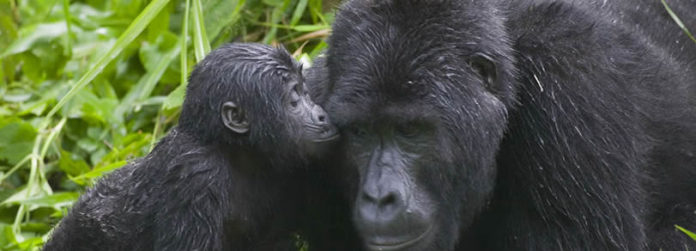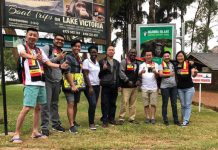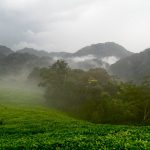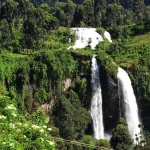Gorilla Trekking
Uganda is well known all over the word as the country with most Mountain Gorillas. In fact Uganda is the best place for Gorilla trekking in Africa and in the entire the world since it has the largest number of gorilla families inBwindi Impenetrable Forest National Park. The park is famous worldwide for gorilla trekking. There are other National parks each famous for different game species such as Kibaale National Park , Lake Mburo National Park, Kidepo Valley National Park and Queen Elizabeth National Park to mention but a few.
Kampala City This is the capital city of Uganda and the commercial heart of Uganda. Here one experiences the true life of Uganda as people live their daily lives. Ranging from using the numerous boda bodas to beat the traffic jam to visiting exciting places and markets within the city. Below are some of the attractions that are located within the heart of Kampala.
The Bahia temple Baha’i
House of Worship Quiet and serenity reflects the spiritual truths of the Baha’i Faith: The oneness of God, the oneness of humanity and the oneness of religion. Like all Baha’i Houses of Worship, the temple in Uganda is circular in shape, has nine sides and is surrounded by exquisite gardens The building and the gardens form a single, sacred space where all people are invited to pray to God and meditate in an atmosphere of beauty and light. The Baha’i Faith recognizes the value of beauty. The word of God reveled in every age is both beautiful and practical-creating a vision of the renewal of civilization. Louis Bourgeois, architect of the temple, conceived of ornamental tracery as embodying and celebrating light-the light of a new revelation from God reveled through Baha’u’llah. Neither of the East nor of the West, the temple design transcends any specific culture, forming a unique structure where the worlds inhabitants can come and be united in prayer.
The Kasubi Tombs

The Kasubi Tombs are located on Kasubi hill 5km away from Kampala city, Uganda, are a significant site where four Buganda kings and other royal family members are buried. This location holds great spiritual and political importance for the Ganda people and showcases traditional African architecture. It was recognized as a UNESCO World Heritage Site in 2001 and praised for its use of natural materials.
The tombs cover about 26 hectares on Kasubi Hill, featuring open agricultural land and a royal palace constructed in 1882. Traditionally, royal tombs were separate, but the Kasubi site houses the tombs of four Buganda kings: Muteesa I, Mwanga II, Daudi Chwa II, and Sir Edward Muteesa II. The main building, Muzibu Azaala Mpanga, is a remarkable circular structure originally built with wooden poles and thatch. In 1938, modern materials like steel and concrete were added during a renovation.
The courtyard is surrounded by traditional structures that serves as the final resting place for royal widows and relatives. The sacred forest within the site, called Kibira, hides the royal tombs from public view. Despite the destruction in 2010, the Buganda Kingdom and the Ugandan government remain committed to preserving this important cultural and historical site.
Unfortunately, in March 2010, a devastating fire destroyed major buildings at the site however the cause of the fire remains unknown and news was spread on the World Heritage Sites.
The fire caused immense sorrow and led to riots during the visit of the Kabaka and President Museveni. Although the tombs’ inner sanctum protected the remains of the kings, the destruction prompted a vow from the Buganda Kingdom to rebuild, with assistance from the national government. The reconstruction began in 2014 with funding from the government of Japan.

The Kasubi Tombs were managed by the Buganda Kingdom until its abolition in 1966, and again after its reinstatement in 1993. They are protected by Ugandan law since 1972, the site is registered in the name of the Kabaka on behalf of the Kingdom. The tombs continue to be a significant spiritual and political center for the Baganda people.
The restoration plan, launched in December 2012 with foreign aid, emphasizes security measures during the reconstruction, limiting access to the tombs. The UNESCO Japanese Funds-in-Trust for the Preservation of the World Cultural Heritage provided support for the reconstruction project, aiming to remove the Kasubi Tombs from the list of World Heritage in Danger and prevent future risks.
The Uganda National Mosque

New York has the Statue of Liberty, Paris has the Eifel Tower, London has the London Eye, India has the Taj Mahal and Kampala has the Gaddafi National Mosque.The Uganda National Mosque, originally named the Gaddafi National Mosque is located 2.5 km from Kampala city center, 47 km from Entebbe airport on Old Kampala Hill, one of the seven prominent hills that define the landscape of Kampala, Uganda’s largest urban center. This mosque, the largest in the East African region and second-largest on the continent, has a rich history that intertwines with the political landscape of Uganda and the generosity of the late Libyan President, Col. Muammar Gaddafi.
History of the Uganda National Mosque
The idea of constructing the mosque was conceived in the 1970s by former Ugandan President Iddi Amin Dada. Amin recognized the absence and need for a significant emblem for the Muslim community, similar to the cathedrals representing the Catholic and Anglican communities on other hills in Kampala. The Uganda Muslim Supreme Council, formed by the government in 1972, lacked a proper headquarters and a symbolic mosque.
The initiative faced setbacks including reluctance from the council despite substantial donations from muslim nations. Amin, frustrated by embezzlement of funds however, ordered the construction of the mosque to commence in 1976. Architect M.A. Karim was tasked to draw up plans, and funding, both indirect and direct, started flowing from Col. Muammar Gaddafi in the 1970s and 2000s, respectively.
Amin’s overthrow in 1979 and a change in the political landscape momentarily hindered the mosque’s construction. However, in 2001, Gaddafi revisited the idea during his visit to Uganda at the invitation of President Museveni. He asked for a chance of having a kampala night tour where he visited places like; Makerere University Hill where he was able to view the tower of the old kampala mosque. This trip was led by Kagimu who re-proposed the idea to Gaddafi, he further arranged between Gaddafi and some Muslim leaders which led to his agreement to fund the construction of a grand mosque at Old Kampala Hill.
Structure of the National Mosque
The mosque was completed in 2006 and became a symbol of religious architectural superiority, seating up to 15,000 worshippers in the main mosque and accommodating a total of 200,000. It has a two-storied structure with large domes covered in brown mosaic, a minaret, where one can view the city. After Gaddafi’s death, its name was changed to the ‘National Mosque’ to ensure maintenance funding continuity from Libya. Eventually, in 2013, it was renamed the ‘Uganda National Mosque.’

Visiting the Uganda National Mosque
The mosque currently serves as the headquarters of the Uganda Muslim Supreme Council, overseeing Islamic affairs in Uganda. Visitors can explore the mosque, situated just 2 kilometers from Kampala city center, during city tours. Modest dress is required, and coverings are provided for those in need. The mosque’s interior reveals intricate Islamic embroidery, architectural wonders, and a sense of awe that pays tribute to a higher power.
Visitors are encouraged to climb the minaret for a unique perspective, leaving their footwear at the entrance as a sign of respect. The mosque is open on special occasions like weddings and Eid days, while its offices on the ground floor are accessible at all times. The Gaddafi National Mosque stands as a religious site and a testament to the cultural, historical, and architectural of Uganda.
The Uganda Martyrs Shrine
This Uganda Martyrs Minor Basilica/Shrine is a Catholic church dedicated to the Martyrs of Uganda who shed their blood because of the Christian faith. The Shrine is well known for its beautiful and unique interior and exterior, but it is specially notable for its shape and architectural plan: the 22 copper pillars-over 100 feet long that support the shrine built in form of an African hut and its wooden doors that depict the history of the Martyrs. The Shrine has a capacity 1000 seats arranged in a circular form. The construction of the Uganda Martyrs’ Shrine began in 1967. It was completed and formally opened by the special Papal envoy, His Eminence Sergio Cardinal Pignedoli on 3rd June 1975.
The Uganda Museum
This museum portrays pre- colonial African History and of the historical items displayed includes the Nakayima tree, Ntusi, Bigo bya Mugyenyi, as well as collection of traditional musical instruments, which one is free to play plus other aspects of Ugandan history which are a good reminder of the country’s colourful past. The Uganda Society’s library is also housed in one rooms of the Uganda National Museum and the collection is comprised of approximately 3,000 volumes, maps, periodicals and photographs, all portraying African history, culture, sociology, travel and science. In addition to the already existing library, it also houses the books of East African wild life Society. Note that the books are currently available for reference only.
White Water Rafting
Uganda is the source of the longest river in the world – river Nile. This river has been a mystery from the time it was discovered by the first explorers – Grant and Speke way back in the 18th century. Adrift Uganda has been carrying out safe water rafting adventure trips for the last 28 years. It is worth the experience.
Lake Victoria
With the all the hustle and dust in the city, lake Victoria, which is the largest fresh water body in Africa offers Ugandans and all visitors to Uganda a place to unwind and relax. The beaches are developed with good service and have enough sand for games, chilling and large enough to offer quiet time for meditation and soul searching.












